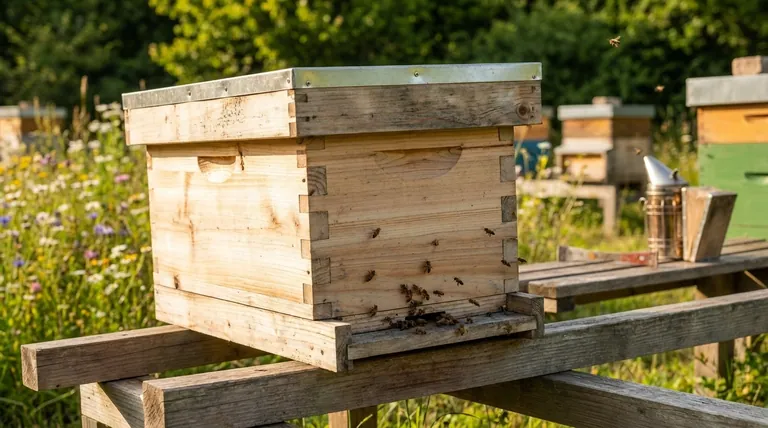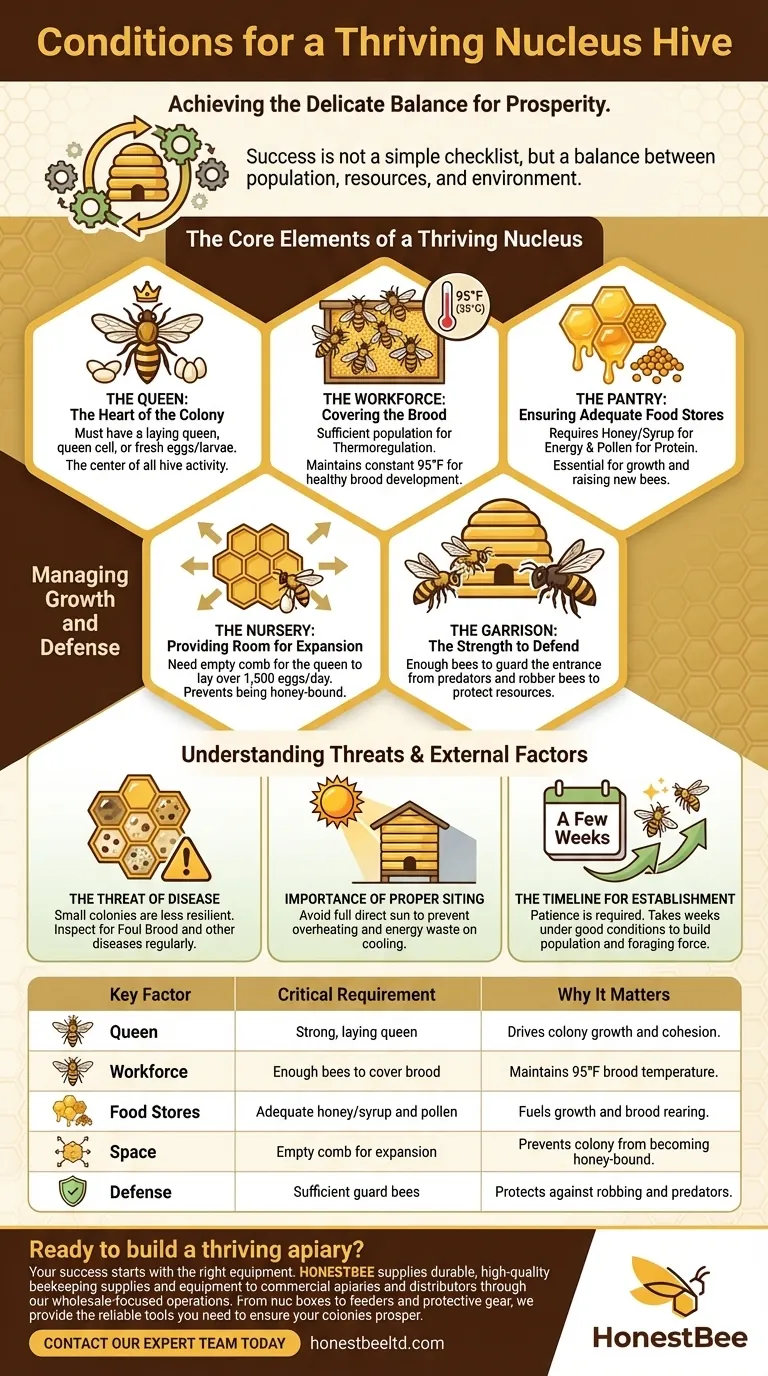For a nucleus hive to prosper, it must achieve a delicate balance between its internal population, available resources, and external environment. This means ensuring there are enough bees to regulate the temperature of the brood, adequate food to fuel growth, sufficient space for expansion, a healthy queen to lay eggs, and the collective strength to defend against threats, all while remaining free from disease and placed in a suitable location.
A nucleus hive's success is not determined by a simple checklist, but by the dynamic interplay of its core components. The beekeeper's role is to manage the critical balance between population, food, and space, ensuring the colony can grow steadily without becoming overwhelmed or resource-depleted.

The Core Elements of a Thriving Nucleus
A nucleus, or "nuc," is essentially a small starter colony. Its fundamental components must be healthy and in proportion for it to have any chance of survival.
The Queen: The Heart of the Colony
Every action in the hive revolves around the queen. A strong, viable queen is non-negotiable.
You must verify the presence of a laying queen, a queen cell from which a new queen will emerge, or at least fresh eggs or very young larvae. The presence of eggs is proof that a queen was active within the last three days and is the best indicator of a healthy colony heart.
The Workforce: Covering the Brood
The bee population must be large enough to perform a critical task: thermoregulation.
Brood (eggs, larvae, and pupae) must be kept at a consistent temperature, around 95°F (35°C). There must be enough adult worker bees to cluster over the frames of brood to maintain this heat. Too few bees for the amount of brood will result in chilled, dead larvae.
The Pantry: Ensuring Adequate Food Stores
A small colony has minimal reserves and can starve quickly. The hive needs both carbohydrates and protein to function and grow.
Honey or sugar syrup provides the energy for all hive activities. Pollen is the protein source essential for raising new bees. A lack of either will immediately halt the colony's development.
Managing Growth and Defense
Once the core elements are in place, your focus shifts to managing the nuc's development and protecting it from outside pressures.
The Nursery: Providing Room for Expansion
A healthy queen can lay over 1,500 eggs per day. The colony needs space to accommodate this rapid growth.
The bees need empty comb or foundation to draw out new cells for the queen to lay in. If all the space is filled with honey or pollen (a condition known as being "honey-bound"), the queen will stop laying, and the colony's growth will grind to a halt.
The Garrison: The Strength to Defend
A small nucleus hive is a tempting target for predators and robber bees from stronger, nearby colonies.
The colony needs enough bees to guard its entrance effectively. A weak nuc can be quickly stripped of its resources by a larger hive, leading to its collapse.
Understanding the Threats and External Factors
Even a well-balanced nuc can fail if it succumbs to external pressures. Vigilance is a key component of successful management.
The Threat of Disease
Small colonies are less resilient to health challenges. Diseases can spread quickly and overwhelm the limited population.
Regularly inspect the brood pattern for signs of disease, such as American or European Foul Brood. A spotty pattern, discolored larvae, or unpleasant odors are all red flags that require immediate attention.
The Importance of Proper Siting
The hive's location has a direct impact on its ability to regulate its internal environment.
A hive placed in full, direct sun during the hottest part of the day can struggle with overheating. The bees are forced to expend precious energy and water just to cool the brood, diverting resources from foraging and growth.
The Timeline for Establishment
Patience is required. A nucleus hive will not become a booming colony overnight.
Under good conditions with a steady nectar flow, it generally takes a few weeks for the bees to build up their population, draw out new comb, and establish a strong foraging force.
Key Checks for Your Next Inspection
Your management strategy should adapt to the colony's needs and your specific goals. During your inspections, assess the hive with these priorities in mind.
- If your primary focus is rapid population growth: Ensure the queen has ample empty comb to lay in and the colony has a steady supply of pollen.
- If your primary focus is survival through a nectar dearth: Prioritize supplemental feeding with sugar syrup and consider reducing the entrance to prevent robbing.
- If you are preparing the nucleus for its first winter: Verify strong brood patterns and ensure the bees have packed away significant honey stores to last the season.
By actively managing these core conditions, you transform a fragile nucleus into a resilient and productive colony.
Summary Table:
| Key Factor | Critical Requirement | Why It Matters |
|---|---|---|
| Queen | Strong, laying queen present | Drives colony growth and cohesion |
| Workforce | Enough bees to cover brood | Maintains 95°F brood temperature |
| Food Stores | Adequate honey/syrup and pollen | Fuels growth and brood rearing |
| Space | Empty comb for expansion | Prevents colony from becoming honey-bound |
| Defense | Sufficient guard bees | Protects against robbing and predators |
Ready to build a thriving apiary? Your success starts with the right equipment. HONESTBEE supplies durable, high-quality beekeeping supplies and equipment to commercial apiaries and distributors through our wholesale-focused operations. From nuc boxes to feeders and protective gear, we provide the reliable tools you need to ensure your colonies prosper. Let's discuss your specific needs—contact our expert team today to get started!
Visual Guide

Related Products
- 5 Frame Wooden Nuc Box for Beekeeping
- HONESTBEE Professional Long Handled Hive Tool with Precision Cutting Blade
- Multi-Function Plier-Style Frame Grip Hive Tool
- HONESTBEE Advanced Ergonomic Stainless Steel Hive Tool for Beekeeping
- HONESTBEE Professional Multi-Functional Hive Tool with Ergonomic Wood Handle
People Also Ask
- What are the benefits of moving nuclei around the apiary? Master Strategic Hive Management
- What is the purpose of having a nuc in beekeeping? Build a Resilient & Productive Apiary
- What is the most common type of standard nuc? The 5-Frame Nuc Explained
- What frames should be moved into the queenless hive when requeening with a nuc? Ensure a Successful Queen Introduction
- What are the benefits of using nucs for beginning beekeepers? Ensure a Successful First Hive with a Head Start



















